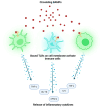Pathogenesis of Inflammation in Skin Disease: From Molecular Mechanisms to Pathology
- PMID: 39337637
- PMCID: PMC11431851
- DOI: 10.3390/ijms251810152
Pathogenesis of Inflammation in Skin Disease: From Molecular Mechanisms to Pathology
Abstract
Many skin diseases begin with inflammatory changes on a molecular level. To develop a more thorough understanding of skin pathology and to identify new targets for therapeutic advancements, molecular mechanisms of inflammation in the context of skin disease should be studied. Current research efforts to better understand skin disease have focused on examining the role of molecular processes at several stages of the inflammatory response such as the dysregulation of innate immunity sensors, disruption of both transcriptional and post-transcriptional regulation, and crosstalk between immune and neuronal processes (neuro-immune crosstalk). This review seeks to summarize recent developments in our understanding of inflammatory processes in skin disease and to highlight opportunities for therapeutic advancements. With a focus on publications within the past 5 years (2019-2024), the databases PubMed and EBSCOhost were used to search for peer-reviewed papers regarding inflammatory molecular mechanisms and skin disease. Several themes of research interest regarding inflammatory processes in skin disease were determined through extensive review and were included based on their relative representation in current research and their focus on therapeutic potential. Several skin diseases such as psoriasis, atopic dermatitis, hidradenitis suppurativa, and scleroderma were described in the paper to demonstrate the widespread influence of inflammation in skin disease.
Keywords: AHR/ARNT; JAK/STAT; NLRP inflammasome; TLRs; atopic dermatitis; hidradenitis suppurativa; neuro-immune crosstalk; non-coding RNA; psoriasis; scleroderma.
Conflict of interest statement
The authors declare no conflicts of interest.
Figures






References
-
- McKernan D.P. Advances in Protein Chemistry and Structural Biology. Volume 119. Elsevier; Amsterdam, The Netherlands: 2020. Pattern Recognition Receptors as Potential Drug Targets in Inflammatory Disorders; pp. 65–109. - PubMed
Publication types
MeSH terms
LinkOut - more resources
Full Text Sources
Medical
Miscellaneous

